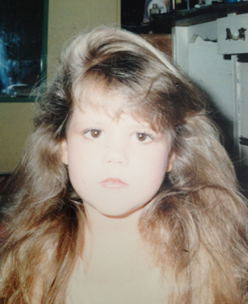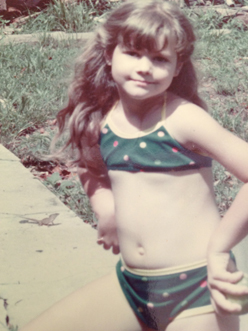The Family Discourse
Made Up Doll
My Aunt Amy took the first photograph to the right after she spent hours making me up. I am five years old in this picture.
My grandmother did not approve of so much make up, yet she dolled me up in a different way. She labored over hand-stitched frilly dresses, enviable works of craft, really. In the second photo, I am wearing such a dress. I am going to a wedding. My grandmother and mother loaned me out as a flower girl for years. They loved the pageantry and the positive gossip that came from such performances, as I was never less than picture perfect: pretty, conversant, demure—a fondant pearl on a wedding cake.
Little Doll Plays a Tune
In the third photo, I am again, performing girl. This photograph is almost 19th century in its arrangement and detail: hair pulled up tight, all crinoline and ruffle, playing the piano dutifully as my grandparents come in from church—an angel in the house.
Not that Kinda Girl
In all three photographs are the tell tale signs of discomfort: the look in the first photograph is not sex appeal but boredom. In the second photograph I am smiling awkwardly. In the third I am painfully upright, stiff. It is all about form, but the form is unnatural. Where are the bugs or the cake batter under my nails?
In the last photograph I am all me. I am wearing flip-flops. I am outside. My hair is long and loose and full of ocean breeze. I am getting ready to do but not perform. I have a ball in my hand, a bathing suit on. I'm irritated that I've been asked to stop and pose, to go back to girl, so I throw a pose that says let's go already.
My ex-boyfriend called this post the "tool-belt" look. It's a stance I still take, unknowingly, when I'm thinking out loud, plotting, fixing, when I'm not performing doll-as-girl, when I am in my own, ready to work, able. It was his least favorite look.
Ripley: Happy to Disappoint You
Entertainment
My mother has married five times. She married my stepfather, L.G., when I was four. We were not good at being a family but we did some things together like movie night, which provided a reprieve from the violence and tension that otherwise plagued our time in that tiny apartment. One night for movie night, we watched Alien.It was a stunning film, terrifying, perfectly electric. Beyond the new monsters and the carnival of gore, what shocked me most was Ripley. I do not remember noticing a strong female lead in a movie. Ripley did not wear a dress. She did not vie for the affection of men. She would save others, instead of being saved. She was a force of Nature and it was, paradoxically, her sex that saved her in the end.
The British science fiction writer David Macintee wrote of Alien, "On one level it's about an intriguing alien threat. On one level it's about parasitism and disease. And on the level that was most important to the writers and director, it's about sex, and reproduction by non-consensual means. And it's about this happening to a man." I would not see any of this until much later, but I was increasingly aware that there was another trope besides girl-as-doll. In this trope, I choose flipflops over black patent leather; career over kids; self over selflessness, which, I have learned, is not the same thing as being selfish. In this trope, I have control over my body and I define what is and is not pretty. I partner because based on love and companionship, not gender or race or cultural comfort. In this trope, there is power in the blood and I do not have to make up or apologize for my sex, or my sexual orientation.
The decade in which Alien and Aliens became popular (81-89). Sandra Day O'Conner became the first woman US Supreme Court Justice. Geraldine Ferraro ran for President. My mother learned that being a single parent would not spell the ruin of her children. And the word mankind became humankind.
Just Get On
History
In a photograph not featured, taken April 4, 1985, I am playing Rabitrella, a rabbit-version of the familiar tale Cinderella. In the American version, Cinderella is an unfortunate whose circumstances suddenly change by the transformative power of her beauty.The photograph was taken at my elementary school. The following January, I, like thousands of other students across the country, were watching the televised launch of the Challenger Space Shuttle.The world had fallen in love with the female teacher, Christa McAuliffe, who was described as having an "infectious enthusiasm" by one NASA official, and was chosen from among 11,000 other applicants to be the first teacher flown into space. McAuliffe said on the Jonny Carson show, "If you're offered a seat on a rocket ship, don't ask what seat. Just get on."
I left home at 16. I fled the madness of a volatile household and the meanness of high school. I finished my G.E.D. with a group of other dropouts, mostly thugs, pregnant teens, the "off labels". I was supremely happy in this space. I had broken free from the corset of how I should do school, do life, do woman. I made all of the biggest decisions in my later life with the same fearlessness—athough some might call it recklessness—with which McAuliffe accepted her spot on the shuttle. It is, perhaps, more dangerous to live wild, and I struggle with this: the need to go so that I can delight in the return, the push and pull of craving freedom versus the cooperation inherent in togetherness, structure versus abandon, blood versus bone.
In her official NASA photograph McAuliffe has on very little makeup. Her hair is natural. She is ebullient but not particularly pretty. She managed to slip from the dress and it will not be her beauty that, in 47 fateful seconds after take off, will transform mere image into iconography. Sometimes, getting to live out loud means we must go down with our ships.
And, as I compare the photographs, I catch an uncanny resemblance.
Ripley is McAulliffe is me.




